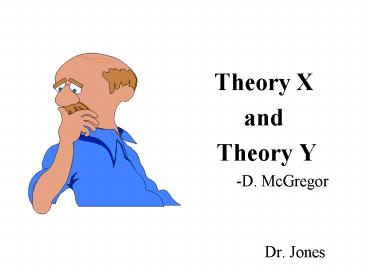Theory X - PowerPoint PPT Presentation
1 / 15
Title: Theory X
1
- Theory X
- and
- Theory Y
- -D. McGregor
- Dr. Jones
2
Theory X
- The traditional view of direction and control.
3
- Behind every managerial decision or action are
assumptions about human nature and human behavior.
4
ASSUMPTIONS
- 1. The average human being has an inherent
dislike of work and will avoid it if he can. - 2. Because of this human characteristic of
dislike of work, most people must be coerced,
controlled, directed, threatened with punishment
to get them to put forth adequate effort toward
the achievement of organizational objectives.
5
- The dislike of work is so strong that even the
promise of rewards is generally not strong enough
to overcome it. People will accept the rewards
and demand continually higher ones, but these
alone will not produce the necessary effort. Only
the threat of punishment will do the trick. - The underlying assumption is that people will
only work under external coercion and control.
6
- 3. The average human being prefers to be
directed, wishes to avoid responsibility, has
relatively little ambition, wants security above
all.
7
- These set of assumptions are referred to as
Theory X. - According to D. McGregor, Theory X provides an
explanation of some human behavior in industry.
8
Theory Y
- The integration of individual and organizational
needs.
9
ASSUMPTIONS
- 1. The expenditure of physical and mental effort
in work is as natural as pay or rest. The average
human being does not inherently dislike work.
Depending upon controllable conditions, work may
be a source of satisfaction (and will be
voluntarily performed) or a source of punishment
(and will be avoided if possible).
10
- 2. External control and the threat of punishment
are not the only means for bringing about effort
toward organizational objectives. Man will
exercise self-direction and self-control in the
service of objectives to which he is committed.
11
- 3. Commitment to objectives is a function of the
rewards associated with their achievement. The
most significant of such rewards, e.g., the
satisfaction of ego and self-actualization needs,
can be direct products of effort directed toward
organizational objectives.
12
- 4. The average human being learns, under proper
conditions, not only to accept but to seek
responsibility. - 5. The capacity to exercise a relatively high
degree of imagination, ingenuity and creatively
in the solution of organizational problems is
widely, not narrowly, distributed in the
population.
13
- 6. Under the conditions of modern industrial
life, the intellectual potentialities of the
average human being are only partially utilized.
14
- Theory Y and Theory X have very different
assumptions.
15
- The central principle which derives from Theory X
is that of direction and control through exercise
of authority. - The central principle which derives from Theory Y
is that of integration the creation of
conditions such that the members of the
organization can achieve their own goals best by
directing their efforts toward the success of the
enterprise.































